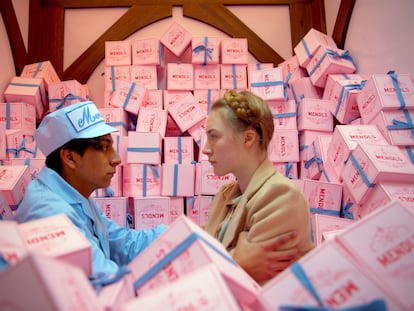No to perfection: The ugly cake rebellion
After years of trying to make cakes that are both perfect and beautiful, the fashion for ‘ugly cakes’ is challenging careful aesthetics and opting for kitschy and grotesque decorations. The tackier, the better
When meme culture, early 2000s tackiness, going viral on the internet, and oodles of sugar come together, a creation is made that borders on bad taste and looks a lot like Harry Potter’s birthday cake, but that’s just fine. After a long time trying to bake the perfect cake, with frosting flowers and tiers decorated with waves of cream — and actually making dry sponge cakes with runny cream cheese frosting straight out of your worst nightmare — it’s time to accept mediocrity and make something ugly fashionable.
The impeccable is the enemy of the possible, or so they say. It shows in the return of the 2000s fashions, with its digital photos (the more pixelated the better) and the meme as an institution that rules the internet. Even Comic Sans has become fashionable again. In this context, an element of pâtisserie has rebelled against extreme styling and has unleashed onto the world (and especially Instagram) terrible, grotesque, and cringeworthy cakes, in which bad taste is deliberately exaggerated.
A different aesthetic
The ugly cakes are here to stay, and I hope they do. The general rule when making a cake is that the result is not very close to looking like the one in the photo, or at least that is what happens to most of us mortals who try our hand at baking. Isn’t it great that now you can bring a cake that has turned out quite average to an event and say that it is the latest fashion? In short, they are cakes that purposely look like they were made by a person who has never cracked an egg in their life. They are sloppy and a little embarrassing, but you find their charm in the end.
This phenomenon has been with us for a couple of years now, so over time the concept has been reshaped and variants have appeared, each one more fun than the last. In short, they are wacky, wild, and imperfect cakes, and we are going to break down the different iterations that we can find.
Before delving into the subject, I think it is essential to review the inspirations from which current trends draw: the cakes with an edible photo covered in a mirror glaze. Or the ones that are made to look like a dress worn by a Barbie doll and can still be seen in the windows of bakeries that opened in the 1980s.
The catalog of cooking magazines from that time — with their candied fruits, animal shapes, and other old decorations — can inspire us if we want to make ugly cakes at home. All fashions come back round: if even low-rise pants could make a comeback, how could cakes not do the same?
Not all ugly cakes have visual (we cannot say aesthetic) pretensions: Ugly Cakery is a bakery in Arkansas where Cindy Koprivnikar has been preparing her grandmother’s recipes for more than 40 years, and she has always maintained the homemade style and a quite traditional appearance in her pastries. “I’m not a cake decorator!” she states. “Our motto is: ‘It’s not pretty, it’s tasty.’ We jokingly suggest ‘eating in the dark’: in a market saturated with edible glitter, frou-frou icing, and baked goods that look like fondant sculptures, we are convinced that taste will always trump presentation.” The demand for the traditional homemade cake also goes through the ugly filter.
There are more versions
The fusion between meme cakes and ugly cakes has given rise to a cake format in which, a funny message or joke is “written” in bad handwriting (not a very complicated thing to do with a pastry bag full of chocolate or cream) on a base of frosting spread as roughly as possible. Colored sprinkles and candies are more than acceptable additives. Food has also entered the world of fashion, and baking has done so fully. In these contexts, cakes are taken to the extreme of aesthetics.
“I think that food in general is experiencing a period of hyperfashion,” says Antonella Tignanelli, food designer and chef. “A cake is no longer a cake. The more complex, attractive, and challenging the image that that cake produces, the more likes. We cannot deny that the dimension of what is edible is also digital.”
Other cakes that have taken over the internet (especially TikTok) are illusion cakes. These are hyperrealistic cakes that look like household objects, foods, or even body parts. Although, what goes into preparing and producing these cakes is the anthesis of making ugly cakes — since the results are almost perfect. However, the extremes do come together, and these cakes that make you doubt reality also have much that is terrible. Have we ditched flavor and baking quality in pursuit of going viral? The hashtag #cakeorfake has more than 30 billion views on the platform, with videos that challenge you to guess if what you see is a cake or a real object. Is this a bad dream?
Ugly cakes have also surpassed the limits of what is ugly, returning to beautiful through the horror vacui, filling all the available space on the cake with colors and textures, glitter and flowers. Some will say that they look like something out of a second-grade art class, but others can surely see perfection in imperfection. These are true works of art made by pastry chefs with a great sense of performance and art direction. Rust Cakes is an artist from Berlin specializing in vegan cakes that are truly museum pieces: their extravagance pulls you in, and you’re not sure if what you want is to sink your teeth into them or put them in a contemporary art gallery.
Another account that can be the last straw for any food stylist is cakes4sport, cakes made by a ceramicist and pastry chef who, between kitsch and rococo, forms sculptural works of powdered sugar and metallic coloring. “I consider my cakes as an extension of my artistic expression,” says Alli Gelles, the creator of what she herself perceives as edible sculptures. “The city and the chaos of everyday life inspire me a lot when it comes to creating, although it is always important to think that the ingredients [should] combine well.”
Prepare them at home
If we can take advantage of a trend to remove complications in the kitchen, let’s do it (but remember to use good technique and produce good work). It’s easy and fun, but of course, don’t think that because the cakes are ugly that you are free to measure and weigh as you please — you still want your cake to be edible. To start, it is best to get a basic cake recipe to follow. It is best to use a round mold and let the cake cool completely once it has been removed from the oven. Meanwhile, you can prepare the toppings that will be used to decorate it.
Once the cake is cold, it can be cut in half and filled. This is where the fun part begins. You can fill a couple of pastry bags with different nozzles and buy or prepare some decorations. The cake can be covered with frosting, but it is fine if it is not perfect — in fact, that’s what it’s all about — with, a decoration here, another there… the more chaotic and crazy, the better. The activity should remind us of when we made sandcastles on the beach as children. As we have said, the more kitsch and tacky elements, the better. So if you have sprinkles or edible glitter, edible flowers or sugar decorations, put them on. Seeing people’s faces when you serve them will be the first triumph. And when cutting it to eat it, no one says that “it’s a shame to cut it because it’s so pretty.”
Sign up for our weekly newsletter to get more English-language news coverage from EL PAÍS USA Edition
Tu suscripción se está usando en otro dispositivo
¿Quieres añadir otro usuario a tu suscripción?
Si continúas leyendo en este dispositivo, no se podrá leer en el otro.
FlechaTu suscripción se está usando en otro dispositivo y solo puedes acceder a EL PAÍS desde un dispositivo a la vez.
Si quieres compartir tu cuenta, cambia tu suscripción a la modalidad Premium, así podrás añadir otro usuario. Cada uno accederá con su propia cuenta de email, lo que os permitirá personalizar vuestra experiencia en EL PAÍS.
¿Tienes una suscripción de empresa? Accede aquí para contratar más cuentas.
En el caso de no saber quién está usando tu cuenta, te recomendamos cambiar tu contraseña aquí.
Si decides continuar compartiendo tu cuenta, este mensaje se mostrará en tu dispositivo y en el de la otra persona que está usando tu cuenta de forma indefinida, afectando a tu experiencia de lectura. Puedes consultar aquí los términos y condiciones de la suscripción digital.
More information
Archived In
Últimas noticias
There is as much life left to discover on planet Earth as that which is already known
Dozens presumed dead, around 100 injured in fire at Swiss Alps bar during New Year’s celebration
Is porn for women different from conventional porn? We spoke to those who make it
Cartagena de Indias is sinking: What can the city do to mitigate it?
Most viewed
- Reinhard Genzel, Nobel laureate in physics: ‘One-minute videos will never give you the truth’
- David King, chemist: ‘There are scientists studying how to cool the planet; nobody should stop these experiments from happening’
- Oona Chaplin: ‘I told James Cameron that I was living in a treehouse and starting a permaculture project with a friend’
- Sinaloa Cartel war is taking its toll on Los Chapitos
- The Interoceanic Train, the Mexican alternative to the Panama Canal











































